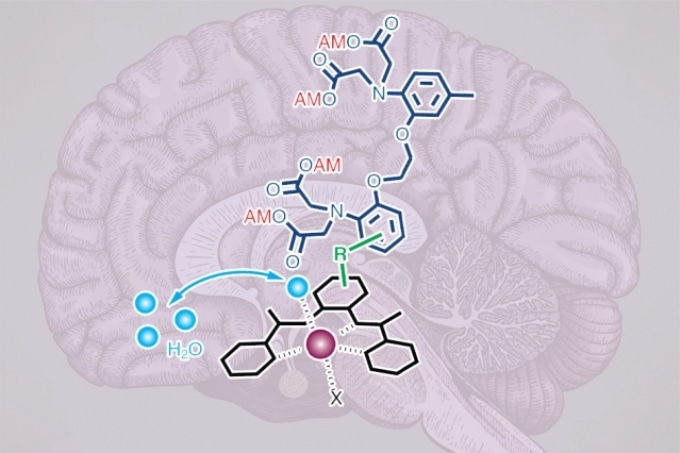Feb 25 2019
Calcium is a crucial signaling molecule for a majority of cells, and it is particularly vital in neurons. Imaging calcium in brain cells can disclose how neurons connect with each other; however, existing imaging methods can only enter a few millimeters into the brain.
 MIT researchers have designed an MRI contrast agent that can detect calcium within neurons, allowing them to closely track brain activity. (Image courtesy of the researchers, edited by MIT News)
MIT researchers have designed an MRI contrast agent that can detect calcium within neurons, allowing them to closely track brain activity. (Image courtesy of the researchers, edited by MIT News)
Currently, MIT scientists have come up with a new method to image calcium activity that is based on magnetic resonance imaging (MRI) and enables them to look much deeper into the brain. Using this method, they can monitor signaling processes within the neurons of living animals, allowing them to link neural activity with particular behaviors.
“This paper describes the first MRI-based detection of intracellular calcium signaling, which is directly analogous to powerful optical approaches used widely in neuroscience but now enables such measurements to be performed in vivo in deep tissue,” says Alan Jasanoff, an MIT professor of biological engineering, brain and cognitive sciences, and nuclear science and engineering, and an associate member of MIT’s McGovern Institute for Brain Research.
Jasanoff is the paper’s senior author, which has been published in the February 22nd issue of Nature Communications. MIT postdocs Ali Barandov and Benjamin Bartelle are the paper’s lead authors. MIT senior Catherine Williamson, recent MIT graduate Emily Loucks, and Arthur Amos Noyes Professor Emeritus of Chemistry Stephen Lippard are also authors of the research paper.
Getting into cells
Neurons, in their resting state, possess very low calcium levels. But, when they shoot an electrical impulse, calcium floods the cell. Researchers over the past several decades have formulated ways to image this activity by classification calcium with fluorescent molecules. This can be achieved in cells grown in a lab dish, or in the brains of living animals, but this type of microscopy imaging can only enter a few tenths of a millimeter into the tissue, restricting most investigations to the surface of the brain.
“There are amazing things being done with these tools, but we wanted something that would allow ourselves and others to look deeper at cellular-level signaling,” Jasanoff says.
To accomplish that, the MIT researchers sought the MRI, a non-invasive method that operates by detecting magnetic interactions between an injected contrast agent and water molecules within cells.
A number of researchers have been exploring MRI-based calcium sensors, but the big problem has been creating a contrast agent that can penetrate brain cells. Last year, Jasanoff’s lab built an MRI sensor that was capable of measuring extracellular calcium concentrations, but these were based on nanoparticles that are very large to get inside cells.
To develop their new intracellular calcium sensors, the scientists employed building blocks that can penetrate the cell membrane. The contrast agent has manganese, a metal that interacts feebly with magnetic fields, bound to an organic compound that can enter cell membranes. This complex also has a calcium-binding arm called a chelator.
Once within the cell, if calcium levels are low, the calcium chelator binds feebly to the manganese atom, protecting the manganese from MRI detection. When calcium enters into the cell, the chelator binds to the calcium and discharges the manganese, which makes the contrast agent seem brighter in an MRI image.
When neurons, or other brain cells called glia, become stimulated, they often experience more than tenfold increases in calcium concentration. Our sensor can detect those changes.
Alan Jasanoff, Professor of Biological Engineering, Brain, and Cognitive Sciences, and Nuclear Science and Engineering, MIT.
Precise measurements
The scientists tried out their sensor in rats by injecting it into the striatum, a region deep inside the brain that is responsible for planning movement and learning new behaviors. They then used potassium ions to trigger electrical activity in neurons of the striatum, and were able to compute the calcium response in those cells.
Jasanoff hopes to apply this method to identify small bunches of neurons that are involved in specific actions or behaviors. Since this technique directly computes signaling within cells, it can deliver a lot more precise information about the site and timing of neuron activity than traditional functional MRI (fMRI), which measures flow of blood in the brain.
This could be useful for figuring out how different structures in the brain work together to process stimuli or coordinate behavior.
Alan Jasanoff, Professor of Biological Engineering, Brain, and Cognitive Sciences, and Nuclear Science and Engineering, MIT.
Furthermore, this method could be applied to image calcium as it carries out many other roles, such as enabling the stimulation of immune cells. With additional modification, it could also soon be used to undertake diagnostic imaging of the brain or other organs whose operations depend on calcium, such as the heart.
The study was sponsored by the National Institutes of Health and the MIT Simons Center for the Social Brain.